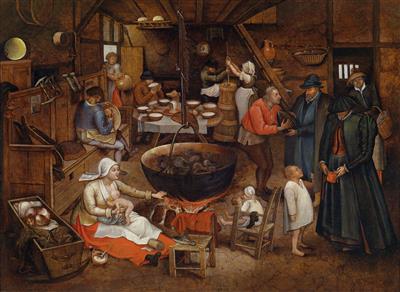ieter Brueghel II

(Brussels 1564–1637/38 Antwerp)
A visit to a farm,
signed and dated bottom right: P.BRUGHEL 1611,
oil on panel, 42 x 57 cm, framed Provenance:
Ince-Blundell Collection, Lulworth Castle, Dorset;
Tasche Collection, Lugano;
with the Alexander Gallery, London;
Anonymous sale, London, Christie’s, 23 April 1982, lot 44, withdrawn;
with William Thuillier, London, from whom acquired in March 1982;
Anonymous sale, Sotheby’s London, 9 July 2008, lot 17, where bought by Galerie d’Art St-Honoré, Paris;
Private collection, Switzerland
Literature:
K. Ertz, Pieter Brueghel der Jüngere (1564-1637/38), Lingen, 1988/2000, 1, p. 482, no. E462
The painting is accompanied by a certificate from Dr. Klaus Ertz.
Both Pieter Brueghel the Younger and Jan Brueghel the Elder, as well as the latter’s son, Jan Brueghel the Younger, treated this subject (A Visit to the Farm) in their painted oeuvre. Yet within the Brueghel dynasty, Pieter the Younger is the one who followed the art established by Pieter the Elder most faithfully. Although Pieter the Younger is certainly not the inventor of this composition, which is set in an interior, he repeatedly varied the theme. For a long time it seems to have been difficult to clearly interpret the scene depicted here. Old inventories refer to the subject as ‘voesterheer’, i.e., ‘foster father’, which would mean that the elegantly dressed gentleman on the right-hand side is the godfather of the newly born peasant child. Today it is generally assumed that this composition depicts the visit of a landlord in the house of one of his tenants on the occasion of the birth of the latter’s third child. As was customary in those days, he presented a sugar loaf and his wife, a coin.
For comparison with regard to the painting’s composition and date, Ertz refers to the following paintings by Pieter Brueghel the Younger:
1. Visit to the Farm (Koninklijk Museum voor Schone Kunsten, Antwerp, signed);
2. Visit to the Farm (Museo Stibbert, Florence, signed and dated 1622);
3. Visit to the Farm (private collection, Sweden, signed and dated 1625).
Ertz summarizes: “Due to the development of space and the treatment of perspective, with objects and figures convincingly assigned to the individual planes, and also because of the homogeneous approach to the scene and the Brueghelian brownish-yellow overall tone keeping the blaze of colours in check, this composition dates from the first half of the 17th century and not, as Pieter Bruegel the Elder’s authorship would suggest, from the 1660s…”.
Expert: Damian Brenninkmeyer
 Damian Brenninkmeyer
Damian Brenninkmeyer
+43 1 515 60 403
oldmasters@dorotheum.com
15.10.2013 - 18:00
- Dosažená cena: **
-
EUR 596.300,-
- Odhadní cena:
-
EUR 350.000,- do EUR 500.000,-
ieter Brueghel II
(Brussels 1564–1637/38 Antwerp)
A visit to a farm,
signed and dated bottom right: P.BRUGHEL 1611,
oil on panel, 42 x 57 cm, framed Provenance:
Ince-Blundell Collection, Lulworth Castle, Dorset;
Tasche Collection, Lugano;
with the Alexander Gallery, London;
Anonymous sale, London, Christie’s, 23 April 1982, lot 44, withdrawn;
with William Thuillier, London, from whom acquired in March 1982;
Anonymous sale, Sotheby’s London, 9 July 2008, lot 17, where bought by Galerie d’Art St-Honoré, Paris;
Private collection, Switzerland
Literature:
K. Ertz, Pieter Brueghel der Jüngere (1564-1637/38), Lingen, 1988/2000, 1, p. 482, no. E462
The painting is accompanied by a certificate from Dr. Klaus Ertz.
Both Pieter Brueghel the Younger and Jan Brueghel the Elder, as well as the latter’s son, Jan Brueghel the Younger, treated this subject (A Visit to the Farm) in their painted oeuvre. Yet within the Brueghel dynasty, Pieter the Younger is the one who followed the art established by Pieter the Elder most faithfully. Although Pieter the Younger is certainly not the inventor of this composition, which is set in an interior, he repeatedly varied the theme. For a long time it seems to have been difficult to clearly interpret the scene depicted here. Old inventories refer to the subject as ‘voesterheer’, i.e., ‘foster father’, which would mean that the elegantly dressed gentleman on the right-hand side is the godfather of the newly born peasant child. Today it is generally assumed that this composition depicts the visit of a landlord in the house of one of his tenants on the occasion of the birth of the latter’s third child. As was customary in those days, he presented a sugar loaf and his wife, a coin.
For comparison with regard to the painting’s composition and date, Ertz refers to the following paintings by Pieter Brueghel the Younger:
1. Visit to the Farm (Koninklijk Museum voor Schone Kunsten, Antwerp, signed);
2. Visit to the Farm (Museo Stibbert, Florence, signed and dated 1622);
3. Visit to the Farm (private collection, Sweden, signed and dated 1625).
Ertz summarizes: “Due to the development of space and the treatment of perspective, with objects and figures convincingly assigned to the individual planes, and also because of the homogeneous approach to the scene and the Brueghelian brownish-yellow overall tone keeping the blaze of colours in check, this composition dates from the first half of the 17th century and not, as Pieter Bruegel the Elder’s authorship would suggest, from the 1660s…”.
Expert: Damian Brenninkmeyer
 Damian Brenninkmeyer
Damian Brenninkmeyer
+43 1 515 60 403
oldmasters@dorotheum.com
|
Horká linka kupujících
Po-Pá: 10.00 - 17.00
old.masters@dorotheum.at +43 1 515 60 403 |
| Aukce: | Obrazy starých mistr? |
| Typ aukce: | Salónní aukce |
| Datum: | 15.10.2013 - 18:00 |
| Místo konání aukce: | Wien | Palais Dorotheum |
| Prohlídka: | 05.10. - 15.10.2013 |
** Kupní cena vč. poplatku kupujícího a DPH
Není již možné podávat příkazy ke koupi přes internet. Aukce se právě připravuje resp. byla již uskutečněna.
